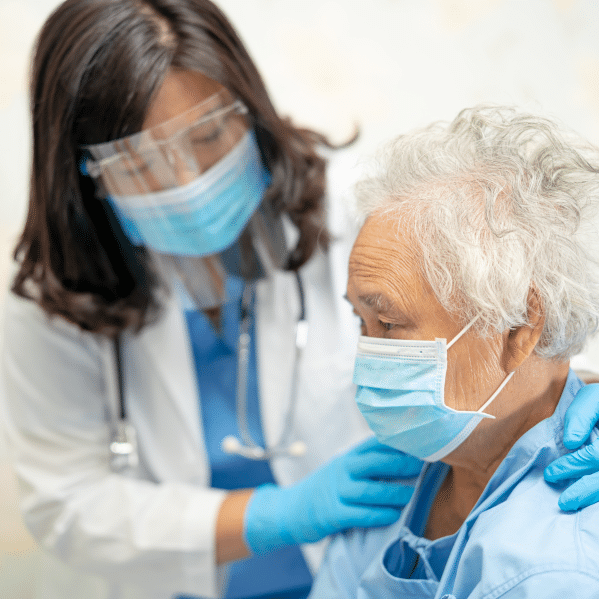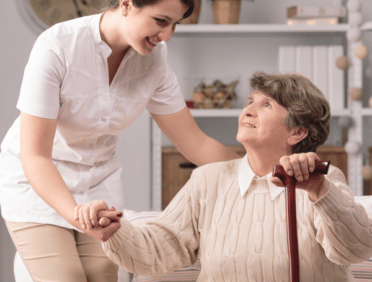What you may not realise about infections is that they work somewhat like a chain. There are many stages of the infection process which need to be passed through in order for the infection to be transmitted to a new host.
If the chain is broken at any point, perhaps by taking the relevant precautionary measures, then the infection will not be transmitted.
The best way to learn more about how infections move from person to person (and then, in turn, how best to stop this from happening) let’s look at the chain of infection and learn more about it.
What is the chain of infections?
No matter the infectious agent, there is a chain that the infection needs to pass through in order for it to be transmitted to a new host. This chain is made from 6 key points, and any of these points can be broken.
If this happens, then the chain is broken, and the infection will not move onto someone else.
What is the chain of infection order?
The first link in the chain is the agent itself. This is the harmful germ or pathogen that has the possibility of causing the infection, then, in turn, the illness or disease. There are a number of agents that could lead to infection; however, the two most popular include bacteria and viruses.
Next is the reservoir or the source. This is the place where the agents “live”. They can use it as a place to thrive and multiply, which will then give it a better chance of moving to a new host.
Whilst many people will think of the source as a person (or perhaps an animal), it can also be in water or in organic matter such as food or soil.
The third link is the link to exit the source. For many agents, this is going to be through the respiratory tract, which is why coughing or sneezing on someone (or in the area where they are breathing) is going to give them a good chance of catching whatever bacteria or virus you may have.
This is why it is vitally important to cover your mouth and nose when you do both of these things. It is also worth noting that some agents can be transmitted through other methods. This could be via membranes throughout the body, such as your eyes, or it could be via your stomach (in the faecal matter, for example).
How this virus is then transmitted is the fourth link. It makes sense that this is linked to the above as the exit and the transmission is going to be via a cough or a sneeze in most people. That said, in the case of transmission from your stomach, this is most likely to come in the form of direct transmission from your skin or from a tainted surface.
Next, we have the fifth link, which is how the agent then enters a new host. This is much the same as how it will leave the host and is largely through being inhaled or taken via the mouth. You may also catch a virus or bacteria through broken skin, or perhaps through touching or being pricked by a used needle.
Finally, we have the last link, which is the person who has been infected and their own susceptibility. If they have a weakened immune system then there is a much greater chance that the agent is going to be able to take hold within them. This will then allow it to find a home (like at the start of the chain) where it can start to multiply, ready for a new infection.
Someone who has a strong immune system is going to stand a much better chance of betting any infection, which means that it won’t be able to take hold and then move on.
What is the chain of infection model?
The chain of infection model describes how microorganisms are able to be transmitted from one person to another. Or one place to another.
We have already covered some of the key points that relate to the spread of infection, so let’s drill down to those a bit closer to see what they mean.
Infectious agent
The first chain is the pathogen or infectious agent itself. These can come in a variety of forms. Some are more common than others, but most of them transmit their infection in the same or a very similar way.
Viruses- one of the most common infectious agents. Examples of this include influenza, shingles and hepatitis
Bacteria- this is another common agent and includes Lyme disease and leptospirosis
Fungi- this includes candidiasis and aspergillosis
Parasitic diseases- such as malaria and toxoplasmosis
Prions- these are responsible for much rarer progressive disorders that are neurodegenerative, such as CJD.
The chance of the agent thriving and being ready to move on to another host will vary. It will need to be able to produce and reproduce its disease; then it will need to be virulent, and it will also need to find it easy to spread.
Reservoir
Next, we have the reservoir, which is where the agent will live. It needs a place to flourish and thrive, giving it the best chance to multiply.
The most common reservoirs in the infection chain include humans, animals, insects and also the environment too.
Humans can either be a carrier of the agent (which is when they do not show any symptoms or feel unwell in any way), or they could be acute, which means that they are infected and are showing signs of this infection. Acute cases are usually picked up and diagnosed, which means that the infection is treated. This reduces the chance of it being transmitted, not only because it has been treated but also because the feelings of being unwell may limit the person from being out and about.
Those who are carriers are more of a risk simply because they do not realise that they are carrying the agent and will freely pass it around with them.
Both animals and insects can carry a variety of agents. Lyme disease is carried in and transmitted by ticks, and rabies is transmitted by dogs, cats, bats and foxes. You can also catch salmonella from certain animals, such as poultry (especially when this meat is eaten) and also sheep, pigs or cows.
Environmental reservoirs are quite a broad group and contain things such as water and soil. Both of which can carry and transmit some quite nasty infectious diseases.
Portal of exit
It is one thing to have these agents within a reservoir, but the next link on the chain requires it to find a way out of its host. The portal of exit will depend on the type of reservoir that the agent has been living in.
For humans (as this is a common infection host that we will come across), there are a number of different avenues through that the agent can exit their host. This could be linked to an ailment, such as vomiting or diarrhoea. It could be via sexual transmission, or it could be respiratory, such as through coughing and sneezing. It could also be through the skin. There are also some agents that can move from a mother to her unborn child through her placenta.
Mode of transmission
As well as being able to exit the host, the agent also needs to find a way to move from their host to a new one. This can either be direct, or indirect.
Direct transmission is usually instantaneous and happens with direct contact. Some of the most common infections that are caused by direct transmission include glandular fever, respiratory diseases and tetanus too.
Transmission can also be indirect; the most common way to indirectly infect someone is airborne. This happens when the infection travels from your body through your respiratory system, sometimes just by the simple act of breathing. It then sits in the air before being inhaled by a potential new host.
Portal of entry into a host
This leads us to the next link, which is the portal of entry. This is how the agent makes its way into the new host. This can happen via inhalation, absorption, ingestion, inoculation and also introduction.
Susceptible host
Finally, we have the host themselves, or the new one should be said. The chance of the agent being able to take root in their body will really depend on whether or not they are a susceptible host. This can vary depending on a number of factors.
Some of the key factors that can make someone a susceptible host include:
Their age
Whether they have dehydration or malnutrition already
If they have any underlying medical issues
If they are immobile
If they take immune suppressant drugs
Transmission Based Precautions
In order to do our best to break the chain of infection, we need to find transmission-based precautions that are going to help to stop it in its tracks. These do vary depending on the nature of the agent, its host and how it is also transmitted too.
Contact precautions
As some agents can be transmitted via direct contact, it is always suggested that healthcare workers wear both gloves and a gown to minimise the chance of contact transmission occurring.
Droplet precautions
To minimise the transmission through droplets, the patient and the worker should wear surgical-grade masks, which help to block the chance of these droplets being released into the air or being breathed in the other end. It is also a good idea to practice cough and sneeze hygiene measures as much as possible too.
Airborne precautions
Airborne precautions work much the same as a droplet. However, another approach that you can take to try and minimise transmission when the agent is in the air is to ensure that the room or space that they are in is well ventilated too.
Infection Control Precautions
We all play a vital part in infection control, and we need to do whatever we can to try and minimise it being able to move around from host to host. The good news is that it is easy enough to do this and ensure that the agents don’t get a chance to be transmitted.
Sanitation
The first is to use sanitation. The best example of this is proper hand washing. The simple act of washing your hands really limits your chance of being the existing or the new host. You should wash your hands on a regular basis, and if you are unable to do so, then you should use proper hand sanitiser to remove the germs.
Disinfection
Surfaces can also be contaminated with agents. This means that you should do as much as you can to disinfect surfaces that are touched, especially on a regular basis. This needs to be completed with the right level of disinfectant; hospital grade is always the best to use.
You also need to ensure that when you are disinfecting surfaces, you are as thorough as you can be.
Sterilization
It is also important to ensure that any tools or equipment that is used in the health care setting is sterilised too. This means that the chance of them harbouring any agents that could then be directly transmitted to a vulnerable person is going to be reduced.
Conclusion
Understanding the chain of infection is crucial to prevent the spread of infectious diseases. By breaking the chain of infection at any point, we can prevent the transmission of the disease to a new host. The six key links in the chain include the infectious agent, reservoir, portal of exit, mode of transmission, portal of entry, and susceptible host. We can take precautions to prevent the transmission of infection through various measures, such as sanitation, disinfection, and sterilization. By implementing transmission-based precautions and infection control measures, we can help to reduce the spread of infectious diseases and protect public health.
To download a .pdf of this blog, please click here












